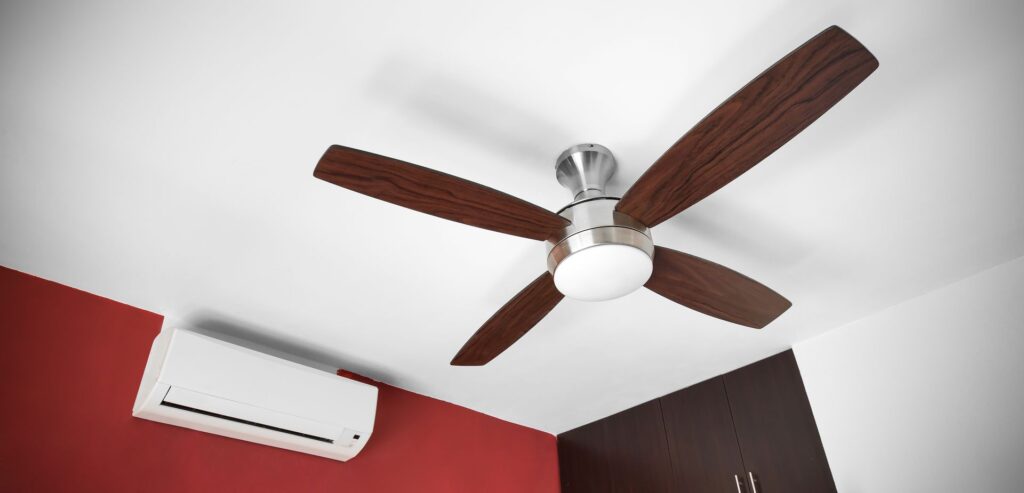Ceiling fans are an essential part of many homes, providing much-needed circulation and comfort, especially during the hot summer months. But how long can you run your ceiling fan continuously without affecting its durability? Let’s dive into this topic and explore the mechanics, factors affecting durability, and maintenance practices to ensure your ceiling fan lasts as long as possible.
Understanding Ceiling Fan Mechanics
Basic Components of a Ceiling Fan
A ceiling fan consists of several key components: the motor, blades, mounting system, and control system. The motor is the heart of the fan, responsible for driving the blades to create airflow. The blades, typically made from wood, plastic, or metal, are designed to move air efficiently. The mounting system ensures the fan is securely attached to the ceiling, while the control system allows users to adjust the speed and direction of the blades.
How Ceiling Fans Operate
Ceiling fans operate by using the motor to spin the blades, which in turn move air around the room. The direction of the blade rotation can be adjusted to either cool the room by creating a wind-chill effect or to circulate warm air during the winter months. Understanding how these components work together is crucial for appreciating how continuous use can impact the fan’s durability.
Factors Affecting Ceiling Fan Durability
Quality of Materials
The durability of a ceiling fan largely depends on the quality of the materials used in its construction. High-quality materials are more resistant to wear and tear, ensuring the fan lasts longer even with continuous use.
Manufacturing Standards
Manufacturing standards also play a significant role. Fans built to stringent quality standards tend to have better longevity compared to those that are not. Checking for certifications and standards compliance can be a good indicator of a fan’s durability.
Installation Quality
Improper installation can lead to imbalances and undue stress on the fan’s components, reducing its lifespan. Ensuring that the fan is correctly installed according to the manufacturer’s guidelines is essential.
Usage Patterns
How frequently and intensely the fan is used will impact its durability. Continuous running, especially at high speeds, can accelerate wear and tear.
Continuous Running of Ceiling Fans
What is Continuous Running?
Continuous running refers to operating the ceiling fan for extended periods without turning it off. This is common in regions with high temperatures or in rooms that need constant air circulation.
Common Reasons for Continuous Running
Some common reasons for running a ceiling fan continuously include maintaining a comfortable indoor environment, improving air circulation in poorly ventilated areas, and aiding in the even distribution of heating or cooling.
Impact of Continuous Running on Ceiling Fan Durability
Heat Generation
Running a fan continuously generates heat, particularly in the motor. Over time, excessive heat can degrade the motor’s components, leading to failure.
Wear and Tear of Components
Continuous operation results in constant stress on the fan’s moving parts, such as bearings and blades. This can lead to increased wear and tear, necessitating more frequent maintenance and repairs.
Motor Longevity
The motor is the most critical component of a ceiling fan. Continuous running can shorten the motor’s lifespan due to overheating and overuse.
Manufacturer Recommendations
Suggested Operating Hours
Manufacturers typically provide guidelines on the recommended operating hours for their ceiling fans. Following these guidelines can help maximize the fan’s lifespan.
Maintenance Tips for Prolonged Use
Regular maintenance, such as cleaning the blades, lubricating the motor, and checking for loose screws, can significantly extend the life of a ceiling fan.
Signs of a Failing Ceiling Fan
Unusual Noises
Unusual noises such as grinding, buzzing, or clicking can indicate that the fan’s components are wearing out or are improperly balanced.
Wobbling Blades
Wobbling blades are a sign of an imbalanced fan, which can cause additional stress on the motor and mounting system.
Reduced Airflow
A noticeable decrease in airflow can signal that the fan’s motor is struggling or that the blades are not functioning correctly.
Maintenance Practices for Enhancing Durability
Regular Cleaning
Dust and debris can accumulate on the blades and motor, hindering performance. Regular cleaning helps maintain optimal airflow and prevents unnecessary strain on the motor.
Lubrication of Moving Parts
Lubricating the motor and other moving parts can reduce friction and prevent overheating, thereby extending the fan’s lifespan.
Tightening Screws and Bolts
Ensuring that all screws and bolts are tight can prevent wobbling and noise, reducing wear and tear on the fan.
Upgrading Your Ceiling Fan
Choosing High-Quality Fans
Investing in high-quality fans can save money in the long run by reducing the need for frequent replacements and repairs.
Energy-Efficient Models
Energy-efficient models consume less power and generate less heat, making them more suitable for continuous running.
Smart Ceiling Fans
Smart ceiling fans offer advanced features such as remote control, scheduling, and energy monitoring, enhancing convenience and efficiency.
Case Studies and Real-World Examples
Examples of Long-Lasting Fans
There are numerous examples of ceiling fans that have lasted for decades due to proper maintenance and high-quality construction. These fans serve as benchmarks for what can be achieved with the right care.
Lessons Learned from Fan Failures
Examining cases where fans have failed prematurely can provide valuable insights into common pitfalls and how to avoid them.
Environmental Considerations
Energy Consumption
Ceiling fans are generally energy-efficient, but running them continuously can still add to electricity bills. Choosing energy-efficient models can mitigate this impact.
Eco-Friendly Fan Options
Eco-friendly fans made from sustainable materials and featuring energy-saving technologies are increasingly available and are worth considering for environmentally conscious consumers.
Cost vs. Durability
Balancing Initial Cost and Long-Term Savings
While high-quality fans may have a higher upfront cost, their durability and lower maintenance requirements can result in significant long-term savings.
Investment in Quality Fans
Investing in a quality ceiling fan can be a wise decision, providing better performance and longer life, ultimately offering better value for money.
Expert Opinions
Insights from Industry Professionals
Industry professionals, including electricians and ceiling fan installers, can offer valuable advice on choosing and maintaining fans for maximum durability.
Recommendations from Electricians and Installers
Electricians and installers often have firsthand experience with various fan models and can recommend the best options based on reliability and performance.
Common Myths About Ceiling Fan Durability
Debunking Misconceptions
There are many myths surrounding ceiling fan durability, such as the idea that running a fan continuously will always lead to a short lifespan. These myths often lack factual basis and can be misleading.
Fact vs. Fiction
Separating fact from fiction is crucial for making informed decisions about ceiling fan use and maintenance. Understanding the real factors that affect durability can help you get the most out of your fan.
Conclusion
In conclusion, understanding the limits of continuous running for ceiling fans is essential for maximizing their durability. By considering factors such as quality, installation, and maintenance, you can ensure that your ceiling fan serves you well for many years. Regular upkeep and investing in high-quality models can significantly enhance the longevity and performance of your ceiling fan, providing both comfort and value.
FAQs
How often should I maintain my ceiling fan?
It’s recommended to clean and inspect your ceiling fan at least once every six months. However, if you use it continuously, more frequent maintenance may be necessary.
Can running a ceiling fan continuously cause a fire?
While it’s uncommon, continuous running can cause the motor to overheat, potentially leading to electrical issues. Regular maintenance and following manufacturer guidelines can mitigate this risk.
What is the best way to clean a ceiling fan?
Use a microfiber cloth or a gentle brush to remove dust from the blades and motor. For a deeper clean, you can use a mild soap solution, but make sure to dry all components thoroughly to prevent moisture damage.
How can I tell if my ceiling fan motor is failing?
Signs of a failing motor include unusual noises, reduced airflow, and increased wobbling. If you notice these signs, it’s best to consult a professional for an inspection.
Are smart ceiling fans more durable?
Smart ceiling fans often come with advanced features that can enhance durability, such as better energy management and more precise control over operation. However, their longevity still depends on the quality of materials and proper maintenance.

